
The Griffin House is a historic house at 200 High Street in Portland, Maine. Built in 1871, it is one of the city's finer examples of Second Empire architecture, and was an early example of the trend to build further away from the city's port district. It was listed on the National Register of Historic Places in 1984.
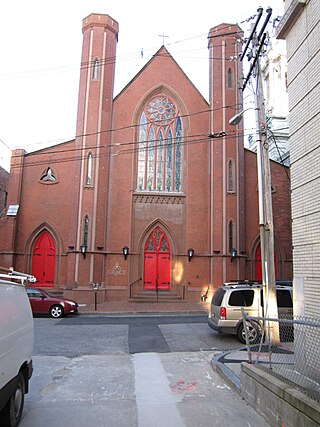
The former Chestnut Street Methodist Church is an historic church building at 15 Chestnut Street in Portland, Maine. Built in 1856, it is rare in the city as an early example of Gothic Revival architecture, and is one of the few surviving works of Charles A. Alexander, a popular architect of the period. The building was listed on the National Register of Historic Places in 1977. It now houses a restaurant.

The Main Street Historic District encompasses the historic commercial center of Damariscotta, Maine. Although the community was settled in the 18th century, most of its downtown area dates to the second half of the 19th century due to an 1845 fire. Lining Main Street east of the Damariscotta River, the downtown has a well-preserved collection of commercial, residential, and civic structures from the period. The district was added to the National Register of Historic Places in 1979, and enlarged in 2001.

The Portland Railroad Company Substation, now the Scarborough Historical Museum, is a former power substation of the Portland Railroad Company, a trolley service provider, at 649 United States Route 1 in Scarborough, Maine. The station was built in 1911, and is one of the few trolley-related facilities surviving in the state. The building was listed on the National Register of Historic Places on March 22, 1991.

The Harrison Bird Brown House is an historic house at 400 Danforth Street in the West End of Portland, Maine, United States. It was built in 1861 for Harrison Bird Brown (1831–1915), one of Maine's best-known painters of the late 19th century, and was his home and studio until 1892. The house was listed on the National Register of Historic Places in 1980.

The Nathaniel Dyer House is an historic house at 168 York Street in Portland, Maine. Built in 1803, it is one of the city's oldest surviving brick houses, rare for the building material and for its scale, which is for a middle-class family of the period. The house was listed on the National Register of Historic Places in 1987.
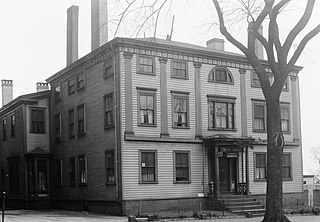
The Joseph Holt Ingraham House, also known as the Churchill and Dole House, is an historic house at 51 State Street in Portland, Maine. Built in 1801, it is an important early design by architect Alexander Parris. State Street, on which the house stands, was laid out by its first owner. The house was listed on the National Register of Historic Places in 1973.

The Asa Hanson Block is a historic commercial building at 548-550 Congress Street in Downtown Portland, Maine. It was built in 1889 to a design by local architect Francis Fassett in partnership with Frederick A. Tompson, and is one of a small number of surviving commercial designs by Fassett in the city. It was added to the National Register of Historic Places in 2001.
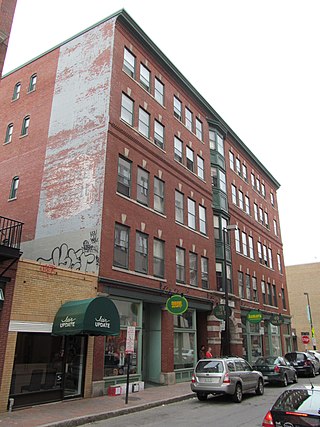
The Everett Chambers or Hotel Everett is a historic mixed-use commercial and residential building at 47-55 Oak Street in Downtown Portland, Maine. Built in 1902 to a design by local architect Frederick Tompson, it is an important surviving example of a lodging house, built early in the transition period from the 19th century boarding house to more modern 20th-century transient accommodations. It was added to the National Register of Historic Places in 2004.

The Portland Packing Company Factory is an historic factory building at 14-26 York Street in Portland, Maine. It was added to the National Register of Historic Places in 1996. Built in 1884, it was home to Maine's oldest and largest vegetable canning company until 1927. After years of neglect, it was rehabilitated in 1995-6. It was listed on the National Register of Historic Places in 1996.

The Hamblen Block or Hamblen's Row is a historic series of four row houses at 188-194 Danforth Street in Portland, Maine, USA, Built in 1835, it is one of the oldest such buildings in the state, and also a rare example, as comparatively few row houses were built anywhere in the state. The row houses were added to the National Register of Historic Places in 1983, and are a contributing property to the larger Hamblen Development Historic District.

The Nathan Harris House is an historic house at 425 Main Street in Westbrook, Maine. Built about 1830, it is a well-preserved example of Federal period architecture, most notable for the murals painted on some of its walls in the 1830s. It was listed on the National Register of Historic Places in 1993. The house is now used as a professional office.

Mechanics' Hall is a historic building and meeting space at 519 Congress Street in downtown Portland, Maine. It was listed on the National Register of Historic Places (NRHP) in 1973 and additional NRHP documentation asserting national significance of the building was approved in 2022. Built in 1857-59 by and for the members of the Maine Charitable Mechanic Association, it is a well-preserved example of Italianate architecture executed in brick and stone, and a landmark of Portland's downtown business and arts district. The building, still owned by MCMA, houses the association's library. The Maine Charitable Mechanic Association was founded in 1815 as a social organization that promoted and supported the skilled trades and their practitioners. Its original members were master craftspeople and entrepreneurs and their apprentices.

The Exeter Waterfront Commercial Historic District encompasses the historic commercial and residential waterfront areas of Exeter, New Hampshire. The district extends along the north side of Water Street, roughly from Main Street to Front Street, and then along both sides of Water and High streets to the latter's junction with Portsmouth Street. It also includes properties on Chestnut Street on the north side of the Squamscott River. This area was where the early settlement of Exeter took place in 1638, and soon developed as a shipbuilding center. The district was listed on the National Register of Historic Places in 1980. It was enlarged in 1986 to include the mill complex of the Exeter Manufacturing Company on Chestnut Street.

The Sawyer Building is a historic commercial building at 4-6 Portland Street in Dover, New Hampshire. The three-story brick structure was built in 1825, during Dover's period of economic prosperity following the establishment of its textile mills. It is one of Dover's oldest commercial buildings. The building was listed on the National Register of Historic Places in 1980.

The Norway Historic District encompasses most of the historic village center of Norway, Maine, and is reflective of the town's growth over 150 years. Although significant early-to-mid 19th century buildings survive in the village, it was significantly damaged by a major fire in 1894, resulting in the construction of a number of new brick and wood-frame buildings. The district, which is 44 acres (18 ha) in size, includes 64 historically significant residential, civic, social, and commercial buildings, and was listed on the National Register of Historic Places in 1988.
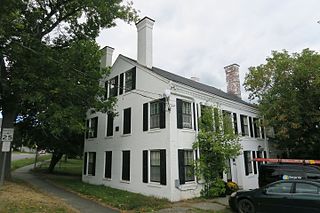
The Wardwell-Trickey Double House is a historic two-family residence at 97-99 Ohio Street in Bangor, Maine. Built in 1836, it is one of the least-altered early duplex brick houses in the city, in a form that were rarely seen in the state outside Bangor. The house was listed on the National Register of Historic Places in 1992.

The Hamblen Development Historic District encompasses a modest collection of Greek Revival residential properties at 188–208 Danforth Street in Portland, Maine. They were built in 1835–36 as a speculative venture by members of the Hamblen family, and are a rare surviving cluster of development in the city from this period. The district was listed on the National Register of Historic Places in 1992.
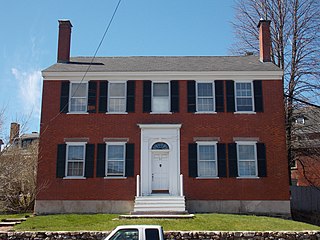
The How Houses are a trio of Federal period houses on adjacent lots facing Danforth and Pleasant Streets in Portland, Maine. Built between 1799 and 1818, they are a surviving reminder of how the surrounding area was once developed; they are now surrounded by more modern commercial properties. They were listed as a group on the National Register of Historic Places in 1980; the Daniel How House was separately listed in 1973.
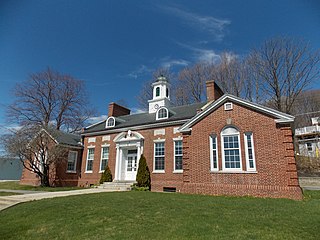
The Maine Publicity Bureau Building is a historic commercial building at 501 Danforth Street in Portland, Maine, United States. Built in 1936, it is a local example of Colonial Revival architecture and was listed on the National Register of Historic Places in 1990 for its association with early formalized efforts by the state to promote tourism.





















